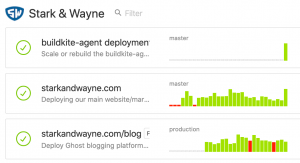Posts by: Ashley Gerwitz

The tenants of immutable infrastructure strongly discourage accessing containers. For day-to-day operation and deployment activities, that’s a sage bit of wisdom. When things start breaking, however, you’ll need to get in and take a look around. Kubernetes gives us two ways of doing this: attach and exec. When you run kubectl exec, you are creating

Ahoy, There! This is just one blog post in an ongoing series about fun things you can do with the Kubernetes CLI, kubectl. We have a whole bunch of these over on our Silly Kubectl Tricks page. Also don’t forget to checkout out the video series on YouTube! If there’s one thing that Kubernetes makes

Is Cloud Foundry dead? I ask on your behalf because Pivotal – chief cheerleader and contributor to Cloud Foundry – was sold to VMWare in 2019, and all Pivotal-cum-VMWare staff chant “Tanzu” as the answer to all problems. During 2017, ’18, and ’19 the vendor ecosystem around “cloud” and “devops” seemed to pine for all

You have many choices for running your tests, deployment, and miscellaneous automation, yet we’ve found more and more individuals and organizations are adopting Buildkite. This 12000-word article will provide you the most in-depth tutorial for getting started with Buildkite. It will cover the basic concepts, setup, secrets, and all the way to how we are

Photo by Kent Weitkamp on Unsplash Great question. The following is a cloud agnostic guide to installing a 3-node RKE cluster, installing the Rancher UI, and using them to run KubeCF on top for a quick, cheap development Cloud Foundry environment. Depending on the IaaS you are deploying on top of you may need to

Photo by Ryan Moulton on Unsplash A ConfigMap is a set of named bits of data. They allow Kubernetes operators to supply additional runtime configuration to the images they are spinning. They can be the source of environment variables. They can even be the source of files on-disk. Consider the nginx image on Docker Hub.

This one goes out to all the cluster operators. It really isn’t fair. All those application folks get to play with cool stuff like automatic traffic routing based on label matches, process resurrection, and more. All services provided by the clusters we run. We’re still on the hook for figuring out how to spin those

I listen to a lot of folks talk about their Kubernetes strategy as a means of apportioning a finite, limited resource (compute) among a wide and varied set of people, usually application developers and operations nerds, with an eye toward isolation. I have bad news for you. Kubernetes isn’t about isolation, not in the security

Ahoy, There! This is just one blog post in an ongoing series about fun things you can do with the Kubernetes CLI, kubectl. We have a whole bunch of these over on our Silly Kubectl Tricks page. Also don’t forget to checkout out the video series on YouTube! Eventually, you’ll write a super handy script